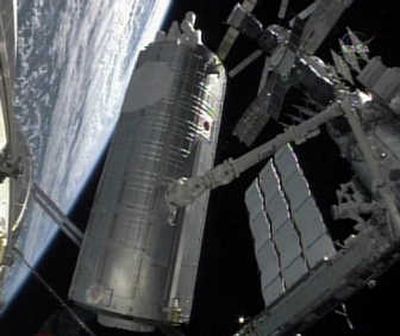Astronauts successfully link lab to space station

CAPE CANAVERAL, Fla. – A team of astronauts working inside and out anchored a giant billion-dollar Japanese lab to the International Space Station on Tuesday, making it the biggest room there.
The long-awaited moment of contact came as two of the crew were winding up a spacewalk.
Spacewalkers Michael Fossum and Ronald Garan Jr. took care of all the preliminaries, removing covers and disconnecting cables on the bus-size lab, named Kibo, Japanese for hope. They left it to their colleagues inside to do the heavy lifting, by way of the space station’s robot arm.
The honor of operating the arm for the installation fell to Japanese astronaut Akihiko Hoshide, who accompanied Kibo to orbit aboard space shuttle Discovery.
“We have a new hope on the International Space Station,” Hoshide announced.
“Fantastic job,” Mission Control replied.
Kibo – a behemoth stretching 37 feet and weighing more than 32,000 pounds – became the largest lab at the space station by 9 feet.
It’s also more sophisticated. Kibo sports a hatch to the outside and a robot arm for sliding out science experiments. A smaller arm will arrive next spring, along with an outdoor porch for holding the experiment packages.
The first part of Kibo – essentially a storage shed – was delivered by the last shuttle crew in March. The astronauts aboard the linked shuttle and station will attach the shed to the lab on Friday.
Japanese Space Agency officials estimate more than $2 billion went into all the pieces, which had to be split up to fit into three shuttle missions. The project has been in the works for more than 20 years.
The astronauts will enter Kibo today. The space station’s two Russian residents, meanwhile, will spend the morning working on the space station’s toilet; the shuttle crew hand-delivered a new pump for the malfunctioning commode.
The lab work was just part of Tuesday’s spacewalk, the first of three planned for Discovery’s nine-day visit.
Fossum and Garan’s spacewalk lasted nearly seven hours. The spacewalkers got off to a late start because of a bad cable in Fossum’s communications cap but soon made up for lost time, helping to remove a 50-foot shuttle inspection boom from the space station.
The laser-tipped pole was left there by the last shuttle crew, for use by Discovery’s astronauts to survey the shuttle’s thermal skin before returning to Earth.
It was the fourth spacewalk for Fossum, a colonel in the Air Force Reserve who is making his second shuttle flight, and the first for Garan, an Air Force pilot.
As the spacewalk got under way, Fossum offered this advice: “Enjoy the view, but don’t look down.”